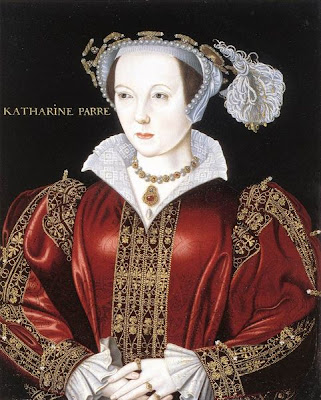Catherine Parr (c. 1512 – 5 September 1548), also known as Katherine or Katharine Parr(e), was the last of the six wives of Henry VIII of England. She was Queen Consort of England during 1543–1547, then Dowager Queen of England. She was the most married queen of England, with four husbands.
Queen consort of England and Ireland
She married Henry VIII on 12 July 1543 at Hampton Court Palace. She was the first English Queen consort to enjoy the new title Queen of Ireland following Henry's adoption of the title King of Ireland. As Queen, Catherine was partially responsible for reconciling Henry with his daughters from his first two marriages, who would later become Mary I of England and Elizabeth I of England. She also developed a good relationship with Prince Edward. When she became Queen, her uncle Baron Parr of Horton became her Chamberlain.
For three months, from July to September 1544, Catherine was appointed Queen Regent by Henry as he went on his last, unsuccessful, campaign in France. Thanks to her uncle having been appointed as member of her regency council, and to the sympathies of fellow appointed councillors Thomas Cranmer and the Earl of Hertford, Catherine obtained effective control and was able to rule as she saw fit. She handled provision, finances and musters for Henry's French campaign, signed five royal proclamations, and maintained constant contact with her lieutenant in the northern Marches, the Earl of Shrewsbury, over the complex and unstable situation with Scotland. It is thought that her actions as regent, together with her strength of character and noted dignity, and later religious convictions, greatly influenced her stepdaughter, Elizabeth I.
Her religious views were complex, and the issue is clouded by the lack of evidence. Although she must have been brought up as a Catholic, given her birth before the Protestant Reformation, she later became sympathetic and interested in the "New Faith".
We can be sure that she held some strong reformed ideas after Henry's death, when the Lamentacions of a Sinner were published in late 1547. However, her work on commissioning the translation of Desiderius Erasmus' Paraphrases shows her more as a MacConica-style Erasmian Pietist.
She was reformist enough to be viewed with suspicion by Catholic and anti-Protestant officials such as Bishop Stephen Gardiner and Chancellor Thomas Wriothesley, 1st Earl of Southampton who tried to turn the king against her in 1546. An arrest warrant was drawn up for her, but she managed to reconcile with the king after vowing that she had only argued about religion with him to take his mind off the suffering caused by his ulcerous leg.
For three months, from July to September 1544, Catherine was appointed Queen Regent by Henry as he went on his last, unsuccessful, campaign in France. Thanks to her uncle having been appointed as member of her regency council, and to the sympathies of fellow appointed councillors Thomas Cranmer and the Earl of Hertford, Catherine obtained effective control and was able to rule as she saw fit. She handled provision, finances and musters for Henry's French campaign, signed five royal proclamations, and maintained constant contact with her lieutenant in the northern Marches, the Earl of Shrewsbury, over the complex and unstable situation with Scotland. It is thought that her actions as regent, together with her strength of character and noted dignity, and later religious convictions, greatly influenced her stepdaughter, Elizabeth I.
Her religious views were complex, and the issue is clouded by the lack of evidence. Although she must have been brought up as a Catholic, given her birth before the Protestant Reformation, she later became sympathetic and interested in the "New Faith".
We can be sure that she held some strong reformed ideas after Henry's death, when the Lamentacions of a Sinner were published in late 1547. However, her work on commissioning the translation of Desiderius Erasmus' Paraphrases shows her more as a MacConica-style Erasmian Pietist.
She was reformist enough to be viewed with suspicion by Catholic and anti-Protestant officials such as Bishop Stephen Gardiner and Chancellor Thomas Wriothesley, 1st Earl of Southampton who tried to turn the king against her in 1546. An arrest warrant was drawn up for her, but she managed to reconcile with the king after vowing that she had only argued about religion with him to take his mind off the suffering caused by his ulcerous leg.

No hay comentarios:
Publicar un comentario